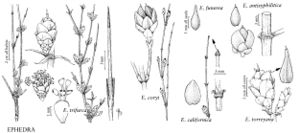Ephedra antisyphilitica
Sér. 6, Sci. Math., Seconde Pt. Sci. Nat. 5(2): 29. 1846.
Shrubs erect or spreading, 0.25–1 m. Bark gray, slightly cracked and irregularly fissured. Branches alternate or whorled, rigid, angle of divergence about 45°. Twigs green, becoming yellow-green with age, glaucous, not viscid, with numerous longitudinal grooves; internodes 2–5 cm. Terminal buds conic, 1–3 mm, apex obtuse. Leaves opposite, 1–3 mm, connate to 2/3–7/8 their length; bases thickened, brown, completely deciduous; apex obtuse. Pollen cones 1–2 at node, lance-ellipsoid, 5–8 mm, sessile to nearly sessile; bracts opposite, 5–8 pairs, pale green to red, obovate, 2–4 × 2–3 mm, membranous, connate at base; bracteoles slightly exceeding bracts; sporangiophores 4–5 mm, 1/2 exserted, with 4–6 sessile to very short-stalked (less than 1 mm) microsporangia. Seed-cones 1–2 at node, ellipsoid, 6–12 mm, sessile to nearly sessile; bracts opposite, 4–6 pairs, ovate, 5–7 × 5–10 mm, connate to 1/8–7/8 their length, inner pairs becoming fleshy and red. Seeds 1 (–2), ellipsoid, 6–9 × 2–4 mm, light-brown to chestnut, smooth.
Phenology: Coning March–April.
Habitat: Arid soils and rocky slopes
Elevation: 100–1200 m
Distribution

Okla., Tex., Mexico in Nuevo León and San Luis Potosí
Discussion
Mexican populations of Ephedra antisyphilitica are disjunct from those in Texas.
Selected References
None.
Lower Taxa
"/8-7/8" is not declared as a valid unit of measurement for this property."/3-7/8" is not declared as a valid unit of measurement for this property.
